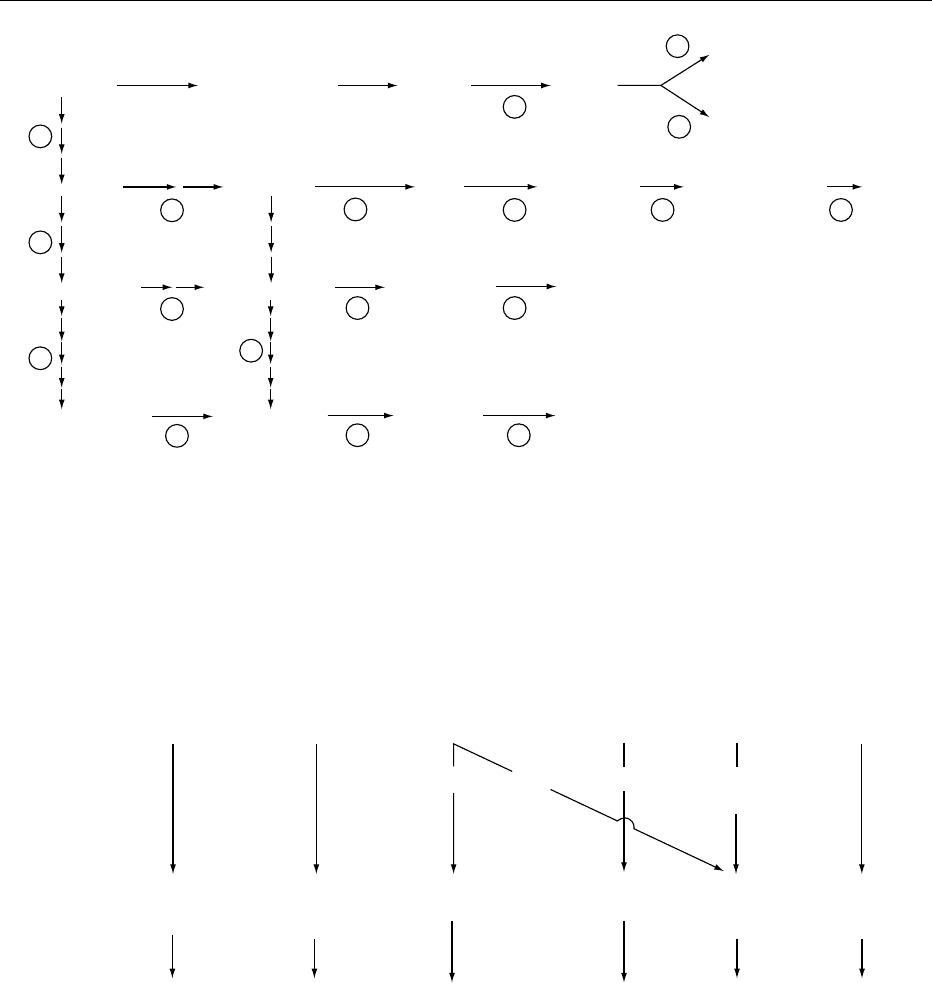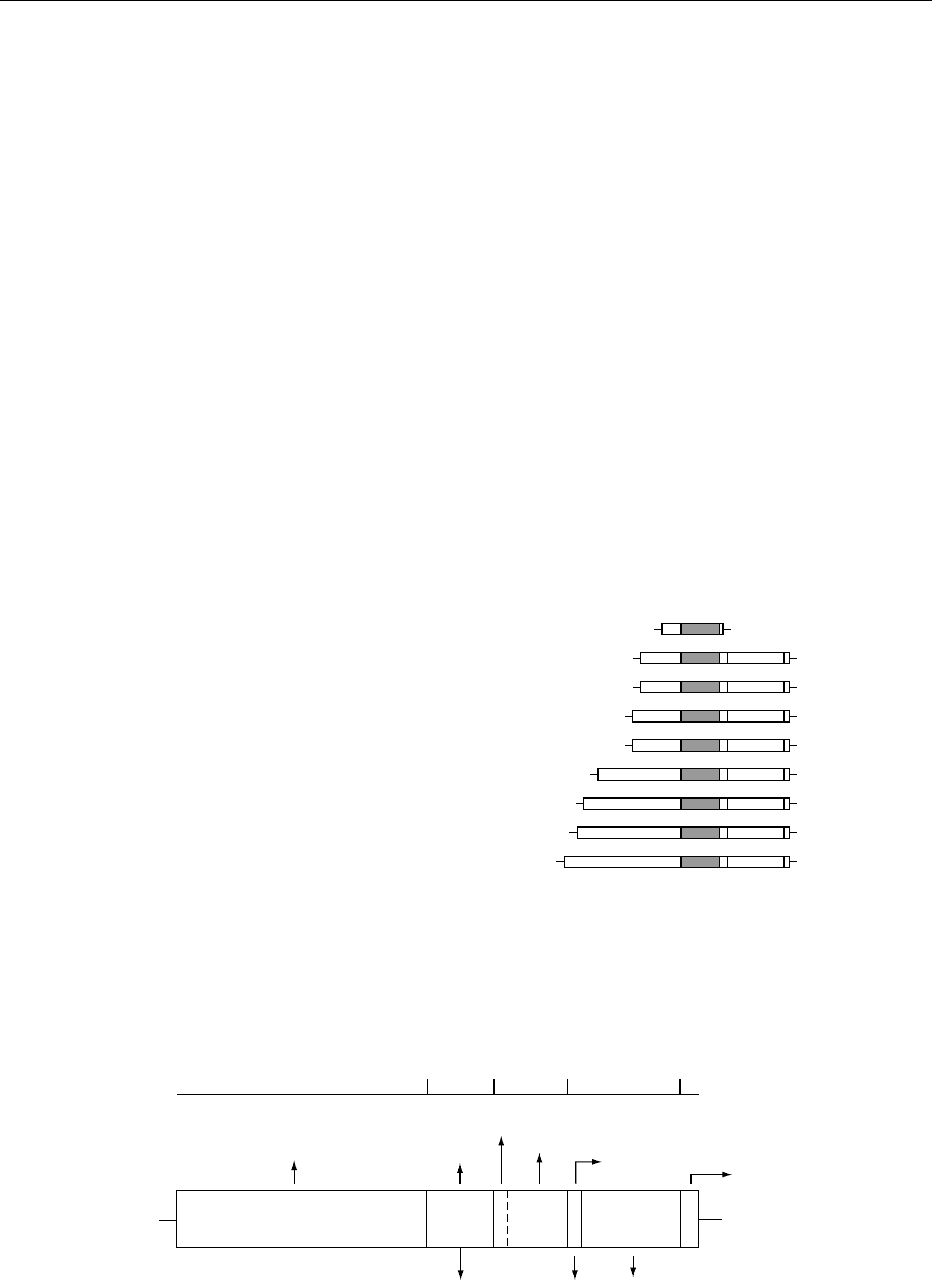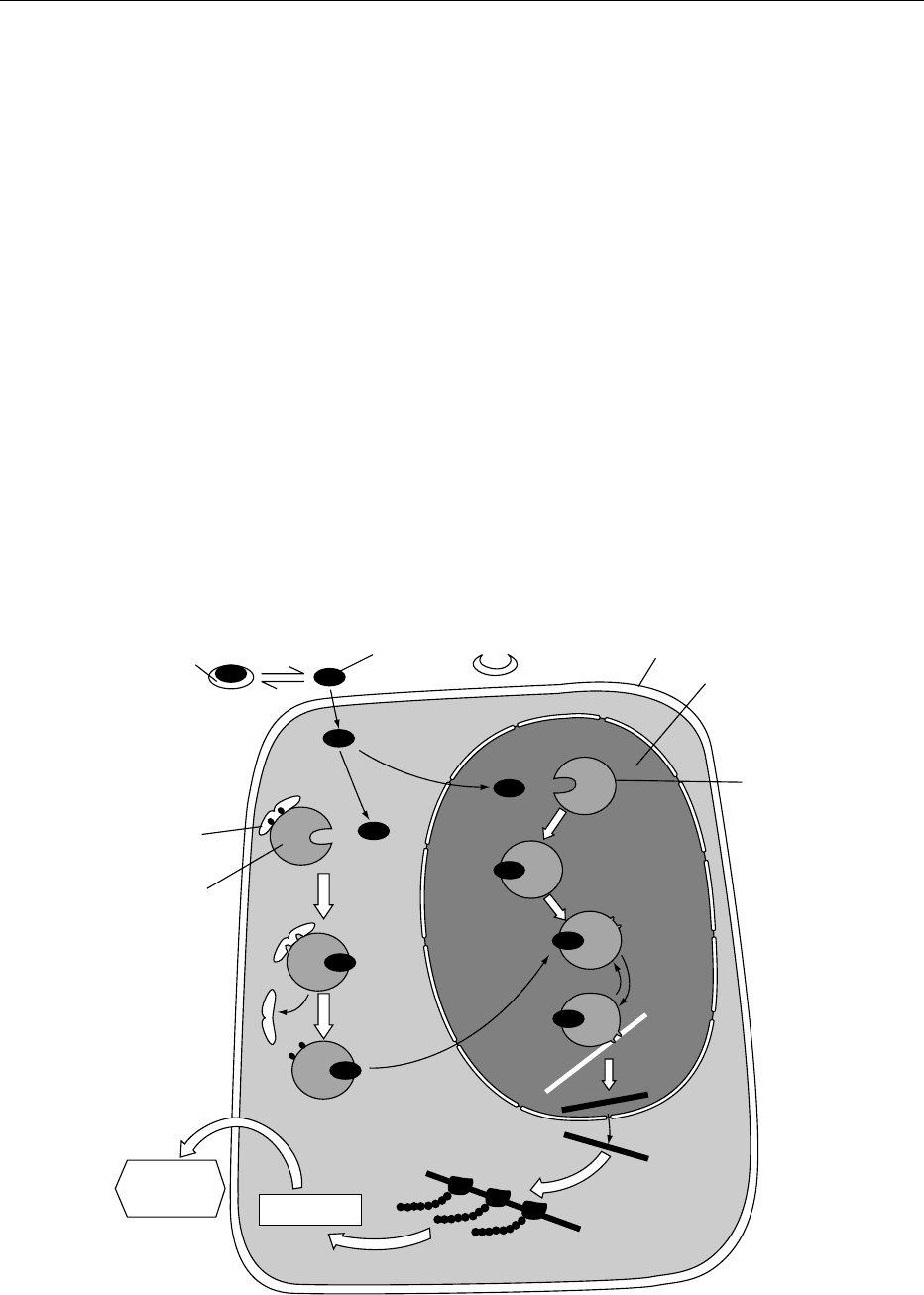Caballero B. (ed.) Encyclopaedia of Food Science, Food Technology and Nutrition. Ten-Volume Set
Подождите немного. Документ загружается.


D
3
(24,25(OH)
2
D
3
), which are instrumental in gener-
ating a wide array of cellular responses. These aspects
are detailed elsewhere in this volume.
Enzymes involved in Steroid Metabolism
0013 Table 1 summarizes some general properties of the
key enzymes involved with conversion of cholesterol
into the six key steroid hormones. The various classes
of enzymes that participate in the biosynthesis of
different steroids include: (1) lyases, which cleave
the carbon–carbon bonds bearing vicinal hydroxyl
groups in the cholesterol side chain; (2) dehydro-
genases and isomerases which convert the 5-ene-3b
hydroxysteroid to 4-ene-3-oxosteroid; (3) aromatase
enzyme (present in the microsomes of placenta and
ovaries), which mediates the aromatization of the A-
ring with a phenolic 3-hydroxyl group in the estro-
gens (Figure 1); and (4) hydroxylases, which play a
key role either in the sequential hydroxylation of
C22, C20, C17 of the cholesterol side chain or in
the stereospecific hydroxylation of the ring structure
to yield the different steroids (Figure 1). Thus, for
example, the three hydroxylases 17a-, 21-, and 11b-
hydroxylase are required for cortisol synthesis, and
the 1a and 24-hydroxylases are involved in the pro-
duction of bioactive vitamin-D metabolites.
0014All these apparently different hydroxylation reac-
tions are mediated by a family of enzymes called
tbl0001 Table 1 Key enzymes concerned with production of steroid hormones
Enzyme
reaction
1
Enzyme Reaction(s) mediated Subcellularlo-
cation
2
Gene location
Long name Short name
a P450 side-chain
cleavage;
formerly known
as desmolase
(P450scc) 20R-hydroxylation;
22R-hydroxylation;
scission of C20–C22 carbon bond
M15
b 3b-Steroid
dehydrogenase-
D
5
, D
4
-isomerase
(Isom) Oxidizes 3b-OH to oxo group;
isomerizes D
5
ene to D
4
ene
ER
c 21-Hydroxylase (P450c21) 21-hydroxylation ER 6p
def 11b-Hydroxylase(P450c11)
3
d11b-hydroxylation; e18-hydroxylation;
f oxidation of C18 hydroxyl to an
aldehyde
M8q
gh 17a-Hydroxylase/
C17–C20 lyase
(P450c17)
4
g17a-hydroxylation; hscissionofC17–C20
carbon bond
ER 10
i 17-Ketosteroid
reductase
(17-oxido
reductase)
Reduces 17-oxo to a 17b-hydroxyl as in
androstenedione!testosterone;
estrone!estradiol;
DHEA!androstenediol
ER
j Aromatase (P450aro) Mediates the aromitization of the A-ring ER 15q 21.1
11 Vitamin D25-
hydroxylase
(P450c25) 25-hydroxylation of vitamin D secosteroids M, ER
12 25(OH)D
3
-1a-
hydroxylase
(P450c1) 1a-hydroxylation of vitamin D secosteroids M
13 25(OH)D
3
-24-
hydroxylase
(P450c24) 24R-hydroxylation of vitamin D secosteroids M
14 5a-Reductase Reduction of D
5
-ene as in
testosterone!dihydrotestosterone
NM
15 Ferredoxin-
oxidoreductase
In the mitochondria transfers electrons from
NADPH to ferredoxin
M 17 con!q25
16 P450 reductase In the endoplasmic reticulum transfers
electrons from NADPH to a P450 enzyme
ER
17 11b-Hydroxy steroid
dehydrogenase
Oxidation of 11b-hydroxyl to an oxo as in
cortisol!cortisone
ER
18 12a-Hydroxylase 12a-Hydroxylation of bile acids ER
19 6b-Hydroxylase 6b-Hydroxylation of bile acids ER
20 7a-Hydroxylase 7a-Hydroxylation of bile acids ER
1
This table summarizes the key enzyme reactions in steroid hormone production (see numbers in circles). Note that, in some instances, the same
enzyme catalyzes more than one reaction. (See footnotes 3 and 4.)
2
Subcellular location coded as M, mitochondria; ER, endoplasmic reticulum; NM, nuclear membrane.
3
Reactions d, e, and f can be mediated by the same enzyme.
4
Reactions g and h are mediated by the same enzyme.
DHEA, dehydroepiandrosterone; NADPH, reduced form of nicotinamide adenine dinucleotide phosphate.
HORMONES/Steroid Hormones 3169

cytochrome P450 hydroxylases which have a cyto-
chrome moiety at the catalytic center. The cyto-
chrome P450 enzymes are present in either the
mitrochondrial or microsomal fraction of cells pre-
sent in the liver, adrenal cortex, ovary, testis, kidney,
placenta, lungs, and intestinal mucosa. The mito-
chondrial cytochrome P450s are comprised of a
flavoprotein dehydrogenase, which accepts electrons
from the reduced form of nicotinamide adenine
dinucleotide phosphate (NADPH), and the nonheme
Cholesterol
7-dehydrocholesterol Vitamin D
3
25-OH-D
3
24,25(OH)
2
D
3
1α,25(OH)
2
D
3
Progesterone DOC
17OH-Progesterone 11-Deoxycortisol
Corticosterone 18OH-Corticosterone Aldosterone
Cortisol
Androstenedione Testosterone Estradiol
Pregnenolone
17OH-Pregnenolone
Dehydroepiandrosterone
(DHEA)
A, O, T, P
A, O, T, P
A, O, T, P
A, O, T, P
A, O, T, P
T, O T,O O
A
A
LS
A
A
S
1
7
2
3 4
4 5
A
K
K
6
A
11
13
12
9 10
3
2
2
8
8
fig0002 Figure 2 Principal pathways of human steroid hormone synthesis. The details of the enzyme reactions (circled numbers) are
summarized in Table 1. Reactions a, b, g, and h are found universally in the adrenals, ovary, testes, and placenta. Reactions i
and j are found principally in the testes and ovaries. Reactions k ! m describe the pathway of production from cholesterol of the
prohormone vitamin D and its hormonal metabolite products 1,25-dihydroxyvitamin D
3
(1a,25(OH)
2
D
3
) and 24,25-dihydroxyvitamin D
3
(24,25(OH)
2
D
3
). Reaction k is P450c25 present in the mitochondrial and/or endoplasmic reticulum of the liver. Reactions l and m:
P450c1a and P450c24 are present in the mitochondria of the kidney proximal tubule. Tissue codes: A, adrenals; O, ovaries; T, testes;
P, placenta; S, skin; L, liver; K, kidney; DHEA, dehydroepiandrosterone; DOC, deoxycorticosterone.
Tropic
hormone
ACTH
Steroid
hormone
Endocrine
gland
Adrenal cortex
(zona
fasciculata)
Glucocorticoids
(cortisol)
Mineralocorticoids
(aldosterone)
Adrenal cortex
(zona
glomerulosa)
Renin−
angiotensin
Luteinizing
hormone (LH)
Testes
(interstitial cells)
(Male) (Female) (Female)
Ovaries
(follicles)
Estrogens
(estradiol)
Progestins
(progesterone)
Vitamin D
metabolites
[1α,25(OH)
2
D
3
]
Kidney
(proximal
tubule)
Ovaries
(corpus
luteum)
(Pregnant
female)
Placental
chorionic
gonadotropin
(hCG)
Parathyroid
hormone
(PTH)
Follicle-
stimulating
hormone
(FSH)
Androgens
(testosterone)
fig0003 Figure 3 Relationship between stimulatory peptide hormones and the production of steroid hormones. For each of the six classes of
steroid hormones, the specific stimulatory or tropic peptide hormone is indicated as well as specification of the organ or cell upon
which it acts. Also, in males, follicle-stimulating hormone is known to act upon the Sertoli cells of the seminiferous tubules to increase
the production not of a steroid hormone but of several sperm proteins, androgen-binding protein, and inhibin, a peptide hormone.
ACTH, adrenocorticotropic hormone.
3170 HORMONES/Steroid Hormones

iron protein adrenodoxin, which accepts electrons
from flavoprotein and transfers them to the cyto-
chrome P450 protein. The microsomal hydroxylase
system lacks the adrenodoxin component. Cyto-
chrome P450 hydroxylases (also known as mixed-
function oxidases) catalyze oxidation-reduction
reactions in which one atom of the substrate (O
2
)
ends up on the steroid as a part of the hydroxyl and
the other oxygen atom as part of water (H
2
O); the
necessary reducing equivalents are derived from
NADPH.
Transport
0015 All steroid hormones, which are quite water-
insoluble, circulate in blood, bound to plasma pro-
teins called steroid hormone-binding globulins. The
androgens and estrogens are both transported by a
plasma b-globulin, which is a hepatic glycoprotein
with a molecular weight of 94 000. This carrier pro-
tein has a high affinity (K
d
1.5 10
10
mol l
1
) for
testosterone, 5a-DHT, and estradiol but not for
progesterone or cortisol. The glucocorticoids are
systemically transported via the corticosteroid-bind-
ing protein (CSBP) or transcortin, which is also a
hepatic protein. Similarly, the vitamin D sterols are
bound to the vitamin D-binding protein (DBP), and a-
globulin. The primary role of all these different sterol-
binding proteins is to provide a reservoir of bound
hormone which can effectively dampen oscillations in
the ‘free’ concentrations of hormones.
Catabolism and Excretion of Steroid Hormones
0016 The catabolic pathways that result in the inactivation
of the steroid hormones occur mainly in the liver.
Conjugation of the hydrophobic steroids either with
sulfate or glucuronides renders the hormone more
hydrophilic for easy excretion in the urine. The
excreted species are usually polyhydroxyl forms
with the particular glucuronide or sulfate: these con-
jugations are mediated by sulfokinase and glucuronyl
transferase enzymes.
Functions of Steroid Hormones
0017 Steroid hormones secreted by the endocrine glands
exert profound influences on cell growth, develop-
ment, and physiology, chiefly by controlling the
synthesis of particular proteins. All steroid hormones
modulate cellular responses by either inducing or
repressing the transcription of specific proteins at
the genetic level.
0018 A general result of glucocorticoid action is a
direct effect of increased glucogen, especially in the
liver, and increases in the levels of circulating glucose.
Prolonged high levels of glucocorticoids can lead to
the death of susceptible cells which accounts for
muscle wasting and immunodeficiency. As a powerful
antiinflammatory agent, glucocorticoids may act
on many cells to induce the synthesis of the protein(s)
lipomodulin. Lipomodulin acts as an inhibitor of
phospholipase A
2
and thereby prevents the release
of prostaglandins, prostacyclins, and leukotrienes,
some of which mediate processes of inflammation
and pain.
0019Mineralocorticoids such as aldosterone promote
sodium reabsorption by the kidney tubules, usually
followed by changes in water balance; in terms of
function they mesh with the vasopressin system and
atrial natriuretic factor which also control water
absorption and excretion by the kidney and also
participate in the regulation of blood pressure.
0020The biological responses of androgens are divisible
into four categories: (1) growth-promoting or andro-
genic effect on the male reproductive tract; (2) stimu-
lating or anabolic effect on body weight (skeletal
growth, skeletal muscle growth, subcutaneous fat
distribution, growth of prostate and seminal vesicle);
(3) development of male secondary sexual character-
istics (growth of external genitalia, enlargement of
larynx and thickening of vocal cords, hair growth
distribution); and (4) actions in the central nervous
system and brain (differentiation of brain cortex,
hypothalamus, initiation of puberty).
0021The dominant effect of estrogens occurs in the
female reproductive tract. Significant biological activ-
ity of estrogens also occurs in the hypothalamus,
brain, and mammary tissue. Estrogens primarily
initiate the transcription of specific proteins in the
uterus, and affect uterine cell proliferation and differ-
entiation. A classical developmental role of estrogen
in the liver of the adult hen is in the induction
of vitellogenin, which is transported to the ovary
and cleaved to yield egg proteins, phosvitin, and
lipovitellin.
0022The biological activity of progesterone is restricted
to the female reproductive tract and mammary tissue.
Some of the effects mediated by progesterone include
thermogenesis in women, regulation of egg move-
ment through the fallopian tubes, preparation of
uterus to receive the blastocyst, alteration of electrical
activity in the brain, control of uterine contraction
(at parturition), and generation of the secretory
system of breast during pregnancy.
0023The steroid hormone 1,25(OH)
2
D
3
is principally
involved in the regulation of mineral (calcium
and phosphorus) metabolism, bone growth, and
differentiation. A detailed account of the manifold
effects of vitamin D is given in a subsequent article.
(See Cholecalciferol: Properties and Determination;
Physiology.)
HORMONES/Steroid Hormones 3171

Mechanism of Action of Steroid Hormones
0024 The receptors for all the steroid hormones,
1a,25(OH)
2
D
3
, thyroid hormone, and retinoic acid,
are all proteins which exist exclusively in the cell
nucleus or are partitioned between the cytoplasm
and nucleus. Each of these receptor proteins functions
as DNA-binding proteins, where they regulate the
expression of genes related to the biological response
of the hormone in question.
0025 Figure 4 presents a generic model of a typical ster-
oid receptor. The protein consists of a single poly-
peptide chain divided into six domains. Starting at
the N-terminus, the domains are respectively (1, 2)
the A/B or variable (sequence and length) domain;
(3) the C or DNA-binding domain which contains
two zinc fingers; (4) the D or variable hinge region;
(5) the E or ligand-binding domain; and (6) the F or
variable domain.
0026 Figure 5 illustrates the striking structural hom-
ology between all the domains of the steroid super-
family. All these proteins are related evolutionarily.
The ancestor of these proteins may be the oncogene
product v-erb A.
0027 The steroid receptors are labile soluble proteins
with molecular weight ranging between 50 and
94 kDa. The molecular cloning of steroid receptors
has greatly facilitated the delineation of the various
functional domains of these receptor proteins
(Figures 4 and 5). All members of steroid receptors
bear a short DNA-binding domain comprising about
70 amino acids containing many conserved cysteine
residues. Eight of the cysteines are organized into two
so-called zinc fingers, each containing four cysteine
residues tetrahedrally coordinating a zinc ion. Based
on the amino acid sequence within the DNA-binding
region of steroid receptors, they can be classified into
two subfamilies: (1) glucocorticoid receptor is the
prototype of the smaller subfamily which includes
progesterone, androgens, and mineralocorticoid re-
ceptors; (2) the estrogen receptor is the prototype
of the larger subfamily which includes the vitamin D
receptors, thyroid hormone receptors, and receptors
for retinoic acid. Steroid receptors exhibit a large
C-terminal domain, responsible for binding hormone,
known as hormone-binding domain (HBD). The
amino-terminal region contains hypervariable amino
acids and certain transactivation sequences. Recent
studies have shown that functional properties of
steroid receptors are modulated by phosphorylation,
dimerization, and association with other proteins
such as heat shock proteins (HSPs).
0028A model of the steroid hormone mode of action is
provided in Figure 6. In step 1, the hormone (H)
dissociates from the plasma transport protein. In
step 2, the hormone enters the target cell by diffusing
through the outer cell membrane. Then, depending
upon the subcellular localization of the unoccupied
receptor, the hormone will either interact with the
receptor in the cytoplasmic compartment (glucocorti-
coid and aldosterone receptors) or continue through
A/B
H
2
N
H
2
N
Transcription
Variable
(immunogenic)
DNA Hinge
Ligand
binding
Transcription
Molybdate
.
HSP
Activation
domain
COOH
Zinc fingers
Homologies: 60−95%
Nuclear translocation
CD E F
COOH
65−75% 30−60%
fig0004 Figure 4 Model of a typical steroid hormone receptor illustrating the six functional domains A ! F. HSP, heat shock protein.
DNA-binding
domain
Hormone-binding
domain
ALDO
PROG
ANDR
CORT
E
2
D
3
RA
T
3
erb-A3⬘5⬘
fig0005Figure 5 Steroid receptor gene superfamily. T
3
, triidothyro-
nine; RA, retinoic acid; D
3
, 1,25-dihydroxyvitamin D
3
,E
2
, estra-
diol; CORT, cortisol; ANDR, androgen; PROG, progesterone;
ALDO, aldosterone. The N-terminal domain (open rectangle to
the left of the DNA-binding domain) represents the sequences of
least homology among the receptors.
3172 HORMONES/Steroid Hormones

the cytoplasm and cross the perinuclear membrane to
interact with a receptor in the nucleus (thyroid, estro-
gen, progesterone, retinoic acid, and 1,25(OH)
2
D
3
receptors).
0029 The unoccupied form of the steroid receptor is
believed to exist in the cell as a conjugate with a
dimer of the 90-kDa HSP; in Figure 6 the HSP
dimer is indicated by a pair of ovals. It has been
suggested that the HSP’s function is to occlude the
DNA-binding domain of the receptor which prevents
the unoccupied receptor from binding to DNA.
0030 In steps 3 and 4, the receptor becomes transformed
or activated as a consequence of release of the 90-kDa
HSP and binding of its cognate ligand, so that the
DNA-binding domain is now exposed. In step 5,
the cytoplasmic activated receptor translocates to
the nucleus, probably through a nucleopore. Then
in step 6, the activated receptor, or more likely a
homodimer of the receptor, seeks out the correct
sequence of DNA that will allow it to form a high-
affinity complex between the receptor and the
hormone response elements (HRE) of the promoters
of a selected set of genes and also any required
transcription factors.
0031As a consequence of the activated receptor binding
to the promoters, either induction or repression of
that gene will occur, leading to more or less of the
mRNA coded for by that gene.
0032The newly transcribed mRNAs are translocated to
the cytoplasm where they become incorporated into
polysomes and undergo translation (step 7). In the
final step, step 8, the increased or decreased amount
of new proteins generates more or less of the bio-
logical response(s) dictated by that hormone in that
target cell. For any given hormone, a wide array of
biological responses can be modulated depending
upon the phenotype of the target cell that possesses
the cognate receptor. In any given target cell pheno-
type, only a small subset of genes will have their DNA
chromatin in an active or open configuration. Thus,
while a hormone may modulate as many as 300 genes
in a given organism, in a specific target cell perhaps
only a few genes will be available for regulation.
Summary
0033Steroid hormones impact profoundly on cellular
metabolism, development, and physiology. The
STEP 1
New protein
STEP 7
STEP 5
STEP 6
DNA
STEP 4
STEP 4
STEP 3
STEP 3
STEP 2
Protein synthesis
mRNA
mRNA
mRNA
Translation
Transcription
Activated
Activated
Activation
Activation
Translocation
of cytoplasmic
receptor complex
Biological
response
Non-DNA-
binding
cytoplasmic
receptor
Plasma
transport
protein with
bound
steroid
hormone
Heat shock
protein
Free steroid
hormone +
Target cell
Nucleus
Nuclear
receptor
fig0006 Figure 6 Model of steroid hormone mode of action. A detailed description is given in the text.
HORMONES/Steroid Hormones 3173

repertoire of cellular responses elicited by the various
steroid hormones is mediated by specific intracellular
receptor proteins localized in target tissues. Cloning
of the receptor genes has allowed detailed structure–
function analysis of these physiologically important
molecules. Greater insight and appreciation of the
complex molecular details of steroid hormone action
should be possible with the application of modern
cellular and molecular biological techniques.
See also: Cholecalciferol: Properties and Determination;
Physiology
Further Reading
Bouillon R, Okamura WH and Norman AW (1995) Struc-
ture–function relationships in the vitamin D endocrine
system. Endocrinology Review 16: 200–257.
Chambon P (1996) A decade of molecular biology of
retinoic acid receptors. FASEB Journal 10: 940–954.
Darimont BD, Wagner RL, Apriletti JW et al. (1998) Struc-
ture and specificity of nuclear receptor–coactivator
interactions. Genes and Development 12: 3343–3356.
Jenster G, Spencer TE, Burcin MM et al. (1997) Steroid
receptor induction of gene transcription: a two-step
model. Proceedings of the National Acadomy of Science
of the USA 94: 7879–7884.
Mangelsdorf DJ, Thummel C, Beato M et al. (1995) The
nuclear receptor superfamily: the second decade. Cell
83: 835–839.
Norman AW and Litwack G (1997) Hormones, 2nd edn.
Florida: Academic Press.
Weatherman RV, Fletterick RJ and Scanlon TS (1999)
Nuclear receptor ligands and ligand-binding domains.
Annual Review of Biochemistry 68: 559–582.
HORSE MEAT
E Rossier, Formerly of CEREOPA, Paris, France
This article is reproduced from Encyclopaedia of Food Science,
Food Technology and Nutrition, Copyright 1993, Academic Press.
Introduction
0001 The custom of eating horse meat is probably as old as
the world itself and, without venturing into prehis-
toric times, the majority of the nations of Antiquity
(Persians, Greeks, Romans, Chinese, Cossacks, etc.)
all ate horse meat.
0002 Paradoxically, in European countries Christianity
has strived to abolish the eating of horse meat since
the seventh century ad. This ban was based on reli-
gious beliefs and was only dispelled after 1870. The
eating of horse meat then developed quickly thanks to
the vigorous action of several well-known personal-
ities in scientific and, in particular, medical circles.
0003 This article explains the situation of the world
market as well as the nutritional and hygienic
qualities of horse meat.
The World Horse Meat Market
0004 Horse meat is produced in several countries, although
the level of production is often marginal when com-
pared to other types of meat.
0005 The USA is the major producer. The other principal
countries are Mexico, Argentina, Canada, China,
Mongolia, Ethiopia, Chile, and Brazil, as well as
several European countries – Poland, Yugoslavia,
France, and Italy. The Commonwealth of Independ-
ent States (former Soviet Union) is also a large
producer although few data are available.
0006The majority of these countries are exporters of
carcass meat, semicarcass meat, quartered or boned
meat, or else of live animals destined for slaughter in
the importing country. In practice, a few countries
dominate trading, the USA being the lead producer,
followed by Argentina and Canada.
0007There are also a few main importing countries and
in these consumption exceeds production which has
diminished as a result of mechanization of agriculture
and transport. This is particularly so in France, Japan,
Italy, Belgium, and the Netherlands. The other mar-
kets are much more limited: Switzerland, Austria,
Sweden, Norway, and Denmark.
0008The internal production of horse meat is adequate
for domestic consumption in Mongolia, China,
Mexico, Ethiopia, and the Commonwealth of
Independent States.
0009In many countries there is a considerable horse
population, but little information is available reg-
arding the final use to which the animals are put,
except in the production of dog and cat food.
0010Except for the countries mentioned above, Italy,
France, Japan, Belgium, the Netherlands, Spain,
Switzerland, and Sweden are the principal consumers
(Table 1). Only small proportions of these
3174 HORSE MEAT

populations eat the meat. This attitude might
change significantly if the meat were promoted with
a specific image in view of the qualities mentioned
below.
0011 There are several restraints on consumption of this
type of meat, in particular cultural or religious pro-
hibitions, the ‘noble animal’ symbolism of horses, and
the often specific distribution channels of horse
butchers, although more widespread distribution is
gradually taking over.
Butcher Qualities
Carcass Characteristics
0012 As horses were not intended to produce meat for
consumption, unlike other species, the meat that has
been eaten has come mainly from grazing animals,
working horses and, more recently, sport and racing
horses.
0013 The growth in production of young meat, espe-
cially from the Trait breed, is new in several European
countries and Japan. The horse is in fact a good meat
producer. Carcass yields are high (real yield is equal
to weight of warm carcass divided by live empty
weight), bordering on 70% for young stallions born
from the Trait breed and comparable with those for
cattle meat.
0014 The carcass contains a very high proportion of
muscle (70%) and little fat (10–14%). The distribu-
tion of adipose tissue is not the same as in cattle, as
horse carcasses contain more subcutaneous and in-
ternal adipose deposits. On the other hand, there is
a smaller proportion of intermuscular fat. Horse
carcasses therefore look more ‘glazed,’ but studies
on the relative growth of different tissues, organs,
and body regions have confirmed that the horse is a
lean animal. (See Meat: Structure.)
Changes to the Meat after Slaughter
0015The physiological principles of postmortem change
are identical for the horse as for other species. How-
ever, horse meat differs from cattle meat in its speed
of maturation. Rigor mortis sets in rapidly (in several
hours), and the pH quickly drops to 5 or 6, which
limits microbial proliferation and allows autolysis of
the muscle. (See Meat: Slaughter.)
0016Horse meat contains a large amount of glycogen
and adenosine triphosphate (ATP) and therefore
retains a degree of plasticity and elasticity for a
long time.
0017Maturation occurs quickly in horse muscle. Most
of the maturation is achieved 4–5 days after slaughter,
allowing the meat to be eaten very fresh. As for pre-
servation, several factors combine to give horse meat
an excellent sanitary quality, including short storage
period for maturation, and low pH. But the large
proportion of glycogen, lactic acid, and nonprotein
nitrogen encourages microbial development. The
meat must therefore be sold quickly and stored at
low temperature before being eaten.
Organoleptic Qualities
Tenderness
0018This criterion largely overshadows other quality
parameters since the consumer’s satisfaction when
tasting the meat depends on this. (See Sensory Evalu-
ation: Texture.)
0019It is the insoluble protein constituents of the meat
which more or less determine its tenderness: the col-
lagen of connective tissue and its degree of polymer-
ization, myofibril proteins, and muscular fibers.
0020It seems that, with horses as with other species,
there are important variations between animals, age,
and different muscles of the same carcass.
0021These variations in toughness result from large
differences in the level of collagen present and its
fluctuation with the age of the animal. The collagen
content is at its maximum at 18 months. The solubil-
ity of collagen, which is linked to its aging and
hardening, seems to reduce rapidly until 24 months
and then stabilizes thereafter. Thus insoluble collagen
reduces the tenderness. Horse meat is generally con-
sidered to be very tender, however, and this quality of
tenderness is one of the consumer’s main reasons for
purchase.
tbl0001 Table 1 National gross production and total consumption of
horse meats in the main consumer countries in 1988
Country National gross
production
(10
3
t)
Total
consumption
(10
3
t)
Belgium and Luxembourg 3 28
Denmark 1 1
France 15 60
Germany 5 5
Italy 14 68
The Netherlands 4 21
Spain 7 7
Japan 4 59
Austria 1 2
Finland 1 1
Norway 1 1
Sweden 2 3
Switzerland 1 4
Yugoslavia 9 1
Source: Organisation for Economic Cooperation and Development (1990)
Meat Statistics, with permission.
HORSE MEAT 3175

Color
0022 It is important to consider the color of horse meat, in
particular minced horse meat, which constitutes a
high proportion of the value of horse carcass. The
color is linked to the myoglobin content in the
muscles. (See Sensory Evaluation: Appearance.)
0023 Adult horse meat is very rich in myoglobin and iron
and looks very red. This is a quality sought after by
consumers in some countries (France), whereas others
(Italy) prefer lighter-colored meats. The level of pig-
ment varies according to the particular muscles
and the age of the animal. The content of heme iron
is still very low at 6 months, giving a very clear,
‘brassy’ meat. A strong color hardly appears before
18 months.
Nutritional Qualities
0024 The structures – particularly of the muscular fibers –
of horse meat are classical and identical to those of
other species. On the other hand, the chemical com-
position of horse muscle is highly characteristic and
conveys particularly interesting nutritional qualities.
Average Composition of Horse Meat
0025 At the beginning of the twentieth century the average
composition of horse meat was published as follows:
water, 74.27%; nitrogenous substances, 21.71%;
fats, 2.55%; nonnitrogenous substances, 0.46%;
mineral materials, 1.01%. More recent writers give
very similar figures, shown in Table 2. Globally,
water content is higher in horse meat than in other
species; a very low lipid content in horse meat also
leads to a low energy value. The high level of water in
horse meat can be a handicap for certain processes
and can present technological problems for the salted
horse meat trades.
Carbohydrates
0026 Horse meat is rich in carbohydrates, especially glyco-
gen. It is one of its main characteristics. It contains
from 0.5 to 3 times more than cattle meat. This high
level of glycogen gives horse meat a sweeter flavor
than beef. (See Carbohydrates: Classification and
Properties.)
Lipids
0027The main dietary quality of this meat is its low level of
lipids. However, this meat is interesting not only in
its low lipid content and its distribution of lipids
throughout the carcass at different adipose deposits,
but also in the structure of these fats. They are mainly
comprised of triglycerides with a high proportion of
unsaturated and polyunsaturated fatty acids: palmi-
toleic acid (C
16:1
), oleic acid (C
18:1
), linoleic acid
(C
18:3
) and arachidonic acid (C
20
). (See Fatty Acids:
Properties; Fats: Classification.)
Proteins
0028The proteins are the major constituents after water.
They can be divided into extracellular proteins, e.g.,
collagen, and intracellular proteins. Horse meat is
interesting not only in its proportion of proteins
but also in the distribution of different amino acids.
The few studies on the amino acid content of horse
meat show a strong percentage of essential amino
acids such as lysine, leucine, and isoleucine. (See
Amino Acids: Properties and Occurrence; Protein:
Chemistry.)
Minerals and Vitamins
0029Principal minerals As shown in Table 3, horse meat
possesses a low sodium content (21 mg per 100 g on
average) and is therefore suitable for those on low-
sodium diets; this meat has a strong image of being
‘good for the health.’ The red color of the adult meat
can darken and turn brown rather quickly as a result
of oxidation, which makes the meat difficult to
present and market. Refer to individual minerals.
0030Trace elements There are heavy metals such as cad-
mium, zinc, and lead in horse meat. Practically all
heavy metals are present but in very small quantities,
with no risk of toxicity. (See Heavy Metal Toxicology.)
0031Vitamins The few reported findings in the literature
suggest the presence of few fat-soluble vitamins and
tbl0003Table 3 Mineral content of horse meat
Minerals Content (mg 100 g
1
freshmatter)
Phosphorus 200
Calcium 4
Sodium 21
Potassium 176
Iron 2.7
Magnesium 4
Sulfur 10
tbl0002 Table 2 Average composition of horse meat (per 100 g of
consumable meat)
Composition Averagevalue
Water (g) 75
Protein (g) 23
Lipid (g) 2
Carbohydrate (g) 1
Energy (kJ) 462–504
3176 HORSE MEAT

more water-soluble vitamins in horse meat. (See Vita-
mins: Overview.)
Hygienic Qualities
0032 Horse meat is reputed for its hygienic qualities as it is
consumed very fresh. It is even common for minced
horse meat to be eaten raw.
Parasitic and Microbial Contaminations
0033 Horse meat is naturally not very contaminated. Al-
though it is claimed to be safe, it must be fresh to be
eaten raw or lightly cooked. In fact, its richness in
glycogen can encourage the growth of microorgan-
isms. Contamination often occurs at the surface and
can easily spread, especially as the meat is often
minced. A strict code of hygiene is necessary. (See
Contamination of Food.)
0034 Parasitic infections are rare but must be given
special attention. Lesions of the digestive tract must
be watched for as well as similar signs of the effects of
parasites in both living and dead animals. (See Para-
sites: Occurrence and Detection.)
0035 Bacteria such as Salmonella are the main agents of
contamination of horse meat. They are easily des-
troyed by cooking heat, but as the meat is often
consumed either without being fully cooked through
or even raw, they can survive in the food. A very strict
code of hygiene is therefore required when working
with horse meat in the slaughterhouse and in the
butcher’s shop.
0036 The transmission of the parasitic disease trichinosis
through the consumption of horse meat was un-
known until roughly 1975. The disease can be spread
amongst carnivores (e.g., dogs, cats, foxes) rodents
(e.g., badgers, rats) and omnivores (e.g., pigs, boars,
bears, humans), and infestation in horses is quite
unusual.
Processing
0037 Horse meat lends itself to butchering and salting
processes, either for typical horse meat products
(e.g., sausages, saveloy, andouilles, smoked hams) or
else in conjunction with other meats. This process has
been developed in Belgium, Italy, and France as well
as in Japan, where hams are reconstituted, often
mixed with other meats. Also in Japan, horse meat
is frequently incorporated into corned beef. (See
Meat: Preservation.)
Conclusion
0038 Horse meat shows many advantages in terms of pro-
cessing and storage, and organoleptic, nutritional,
and hygienic qualities.
0039Some of the special characteristics of this meat are
carried over from generation to generation: it is the
meat to treat anemia; it is meat suitable for tubercu-
losis diets; it is the meat for energy; these are special
characteristics familiar to nutritional biochemists.
0040These characteristics, in the current context of
competition between meats and other available
sources of proteins, and as a result of changes in
eating habits in recent years, make horse meat, at
the very least, a most interesting meat with the
following advantages: high butcher yields; high levels
of glycogen and good-quality proteins (essential
amino acids); low contents of salt and lipids; tender-
ness associated with collagen characteristics and their
distribution; a characteristic sort of fatty tissue with a
predominance of unsaturated fatty acids; safe in
terms of residues or contamination provided that the
conditions of slaughter, transport, storage, and distri-
bution are satisfactory in order to reduce as much as
possible the dangers of microbial infection.
0041Ultimately, horse meat not only possesses obvious
dietary qualities for people in good health and par-
ticularly for children, but also is very suitable for
those on special diets or everyday diets, e.g., diabet-
ics, obese subjects, those with gout, hypercholesterol-
emia, hypertriglyceridemia, gastrectomy or kidney
insufficiency, and those following a residue-free diet
or a low-sodium diet.
See also: Amino Acids: Properties and Occurrence;
Carbohydrates: Classification and Properties;
Contamination of Food; Fats: Classification; Fatty
Acids: Properties; Heavy Metal Toxicology; Meat:
Structure; Slaughter; Preservation; Parasites:
Occurrence and Detection; Protein: Chemistry; Sensory
Evaluation: Appearance; Texture; Vitamins: Overview
Further Reading
Anderson G and Lee D (1976) Salmonella in horses: a
source of contamination of horse meat in a packing
plant under federal inspection. Applied and Environ-
mental Microbiology 31(5): 661–663.
Catalano AL and Quarantelli A (1979) Carcass characteris-
tics and chemical composition of the meat from milk-fed
foals. La Clinica Veterinaria 102(6–7): 498–506.
Cattaneo P, Radaelli A and Cantoni C (1979) Solubilite
´
des
fractions azote
´
es du muscle de cheval. Archivio Veteri-
nario Italiano 30(1–2): 47–48.
Martin-Rosset W, Boccard R, Jussiaux M, Robelin J and
Trillaud-Geyl C (1983) Croissance relative des diffe
´
rents
tissus, organes et re
´
gions corporelles entre 12 et 30 mois
chez le cheval de boucherie de diffe
´
rentes races lourdes.
Annales de Zootechnie 33(2): 153–174.
Organisation for Economic Cooperation and Development
(1991) Meat Balances in OECD Countries, p. 147.
Paris, France: OECD Publications.
HORSE MEAT 3177

Otake Y and Nakazato T (1972) Fatty acid and triglyceride
composition of horse meat lipids. Japanese Journal of
Zootechnical Science 43(11): 631–637.
Renon P, Comi G and Cantoni C (1979) Acides gras du tissu
adipeux de cheval. Archivio Veterinario Italiano 30
(1–2): 35–40.
Robb J, Harper RB, Mintz HF, et al. (1972) Chemical
composition and energy value of the body, fatty acid
composition of adipose tissue and liver and kidney size
in the horse. Animal Production 14(1): 25–34.
Robelin J, Boccard R, Martin-Rosset W, Jussiaux M and
Trillaud-Geyl C (1984) Caracte
´
ristiques des carcasses et
qualite
´
s de la viande de cheval. In: Jarrige R and Martin-
Rosset W (eds) Le Cheval, pp. 601–610, Paris: Institut
National de la Recherche Agronomique.
Rossier E and Berger C (1988) Horse Meat: Great but
Unknown Qualities, p. 37. Paris: Centre d’Etude et de
Recherche sur l’Economie et l’Organisation des Produc-
tions Animales and Institut Technique de l’Elevage
Bovin.
United Nations Conference on Trade and Development/
General Agreement on Tariffs and Trade (1983) The
World Market for Horsemeat, p. 120. Geneva: Inter-
national Trade Centre.
HPLC See Chromatography: Principles; Thin-layer Chromatography; High-performance Liquid
Chromatography; Gas Chromatography; Supercritical Fluid Chromatography; Combined Chromatography and
Mass Spectrometry
HUNGER
J Blundell and A Gillett, The University of Leeds,
Leeds, UK
Copyright 2003, Elsevier Science Ltd. All Rights Reserved.
Hunger and the Regulation of Appetite
0001 Hunger refers to a drive or state of motivation that
impels animals to search for food. In humans, hunger
represents a subjective experience or feeling that is
associated with the desire to obtain and eat food. This
is how the word ‘hunger’ is used in everyday social
discourse, and scientific methods have been applied
to understand the mechanisms underlying this
common subjective experience. From a functional
point of view, hunger achieves a purpose: that nag-
ging feeling, the presence of which serves to stimulate
thoughts about food and eating, is useful and reminds
us that the body needs food. In this way, hunger can
be seen to possess a clear biological function.
Measurement of Hunger
0002 How do we describe the experience of hunger as it
occurs in everyday life? More than 25 years ago, a
serious attempt was made to investigate this issue by
giving people a questionnaire that asked about phys-
ical sensations in a number of bodily areas, moods,
urges to eat, and preoccupation with thoughts of
food. The questionnaire was completed before and
after eating. It was found that the observation ‘I feel
hungry,’ is typically based on the perception of bodily
feelings, which at times may be very strong. Gastric
sensations, a hollow feeling, or stomach rumbling,
are frequent indicators of hunger, although people
also report sensations in the mouth, throat, and
head. These accompany more diffuse feelings of rest-
lessness and excitability as well as an urge to eat.
In one celebrated project, known as the Minnesota
experiment, a group of volunteers were placed on
a semistarvation diet for 6 months, and their
experience of hunger was extreme. Nearly two-thirds
reported feeling hungry all the time, and a similar
proportion experienced physical discomfort due
to hunger. Subjects experienced a marked increase
in what was referred to as ‘hunger pain.’ For
some, this pain, vaguely localized in the abdomen,
was of mild discomfort. For others, it was intensely
painful.
0003Eating changes both the pattern of physical
sensations and the accompanying emotional feelings,
with unpleasant and aversive sensations being
replaced by pleasant sensations. For example, an
aching stomach becomes relaxed, and the feeling
of excitement and irritability is replaced by one of
contentment.
3178 HUNGER
